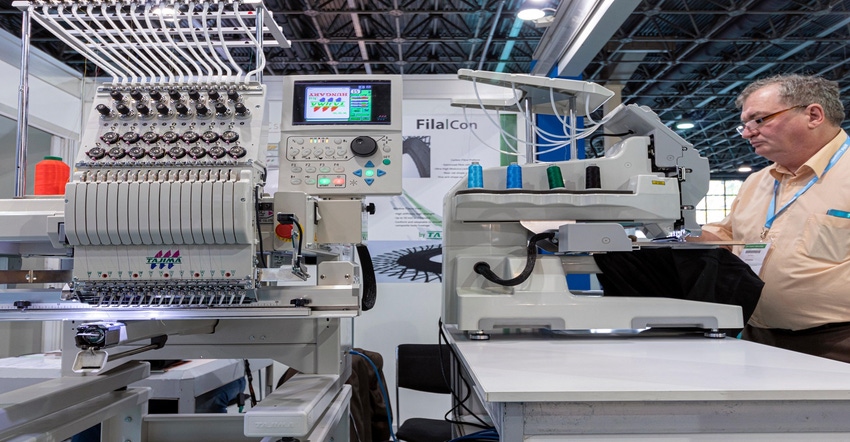The textile industry is struggling to reinvent itself with new technology while facing supply chain issues and a 20% labor shortage.
June 15, 2022

The national industrial problems of materials shortages, technology challenges, missing workers, and reshoring were on full display at the IME South Design and Manufacturing Conference. The textile sector’s problems are like a fractal of the issues facing industry across the US.
During the panel, Everything Old Is New Again – Reviving a Legacy Industry in the US, experts in textiles ticked off the same problems that lead the headlines across the country. But here, the challenges seemed more daunting. The textile industry is struggling with a 20% labor shortage, aging equipment, and difficulties in obtaining raw materials.
There is also the unique difficulty of overcoming the stigma of past labor issues in textiles. “I’m challenged to work with the new generation and let them know the textile industry does not use child labor,” said panel moderator Jordan Schindler, CEO of Nufabrix. “Textiles is a forgotten industry. It’s more advanced now with innovation, but it’s difficult solving big problems in a world with negative connotations.”
Nufabrix makes clothing infused with medical and health materials. Users can absorb the medicine and or health chemicals all day while wearing Nufabrix clothing. Schindler moved his company from the West Coast to North Carolina to be closer to the textile manufacturing industry.
Labor and Materials Shortages
Panelists agreed that the biggest issue currently facing the textile industry in North Carolina is getting the material to produce products. “Raw materials and supply chain issues are putting the greatest strain on the industry. Every company is saying that,” said Jasmine Cox, head of programs at the Textile Technology Center.
North Carolina and the surrounding states were home to the core textile industry in North America. “There were 1500 textile companies in North Carolina and its bordering states,” said Jur, professor of textile engineering at North Carolina State University. Then the textile industry has changed drastically. “Twenty years ago, there were 250,000 textile workers in North Carolina. Now there are 40,000. We’re trying to change that by bringing textile manufacturing back onshore,” said Jur,
The migration offshore was driven partially by the need to manufacture products near the source of the raw materials. “Textiles are commodity products with low margins,” said Jur. The industry didn’t have the raw material supplies in the US, so textile companies had to situate themselves outside the US near the raw materials.”
Part of the problem is that the plants twenty years ago were inefficient. That has changed. With updated factories, once unprofitable plants can be brought back to life. “If the plants had been reliable, they would still be around,” said Adrian Messer, VP of education services at Proeli. “By using asset reliability and predictive maintenance, you can increase throughput without additional assets.”
Identifying Workers in Mid School
With profound labor shortages, the industry is getting creative in finding ways to bring in new workers. “It’s a challenge making sure there are enough people to support the growth,” said Jur. “Right now, textile companies are 20 to 30% understaffed. They’re at full capacity. Sales folks can’t sell when you’re at full capacity.”
The industry is looking to mid-schools to identify future workers. “To solve the shortage of labor, we’re creating apprenticeships,” said Messer. “Companies are identifying future workers in mid-school. They’re looking at which kids are working with technology projects. Their recruiting from the schools that have technology programs.”
While it may seem odd to begin recruiting efforts earlier than high school, it turns out that high school is too late to begin the recruiting effort. “We have to reach out before high school,” said Jasmine Cox, head of programs at the Textile Technology Center. “By high school, the kids already know what they want to go. We have to work with the mid schools to develop programs, and textile classes. We get them in Pre-apprenticeship programs in the summer.”
Creating a New Textile Industry
Across North Carolina, companies and government entities are pushing the industry into the future. “We’re working to get the industry to understand the value of new technology,” said Jure. “These companies are calculating the ROI of new technology and their views are changing quickly.”
Academic and government agencies have created programs to encourage the adoption of new technology in the textiles industry. “We’re repositioning textiles with coordinated investment strategies,” said Jur. “The federal government is asking us to do that, to explore higher-value-add manufacturing systems that are trustworthy.”
The federal government is also offering financial incentives to improve textile manufacturing. “We get development grants,” said Schindler. “We work with chemical suppliers and technology companies. There are also a lot of collaboration opportunities for manufacturers.
The collaboration effort involves pairing advanced companies with those still working with legacy systems. “At our tech center, our goal is to work with the older companies and connect them with people using advanced technology,” said Cox. “They can’t just do it in-house, so we partner them with companies that have the knowledge.”
About the Author(s)
You May Also Like





